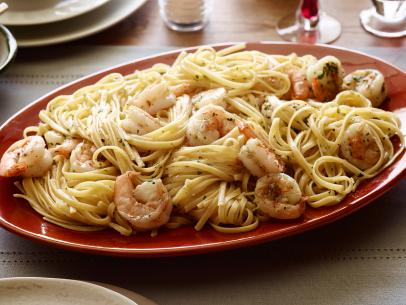
Recipe courtesy of
Andy Liang
for
Food Network Kitchen
Recipe courtesy of
Andy Liang
for
Food Network Kitchen
Watch how to make this recipe.
Har Gow
Getting reviews...
- Level: Intermediate
- Total: 1 hr 45 min (includes soaking time)
- Active: 1 hr
- Yield: 8 servings (30 dumplings)
-
- Nutritional Analysis
- Per Serving
- Serving Size
- 1 of 8 servings
- Calories
- 183
- Total Fat
- 4 g
- Saturated Fat
- 0 g
- Carbohydrates
- 24 g
- Dietary Fiber
- 0 g
- Sugar
- 1 g
- Protein
- 11 g
- Cholesterol
- 91 mg
- Sodium
- 602 mg
Har gow--or crystal shrimp dumplings--are a staple on any dim sum restaurant table. Known for their slightly chewy translucent skins, bright orange shrimp filling and many small pleats, they are the hallmark of a great dim sum chef: the more pleats and the more translucent the skins, the more skilled the chef. Using a baking soda soak helps improve the texture of the shrimp, making it more "snappy," while slowly adding boiling water to the wheat starch helps create the signature translucent skins.
- Level: Intermediate
- Total: 1 hr 45 min (includes soaking time)
- Active: 1 hr
- Yield: 8 servings (30 dumplings)
-
- Nutritional Analysis
- Per Serving
- Serving Size
- 1 of 8 servings
- Calories
- 183
- Total Fat
- 4 g
- Saturated Fat
- 0 g
- Carbohydrates
- 24 g
- Dietary Fiber
- 0 g
- Sugar
- 1 g
- Protein
- 11 g
- Cholesterol
- 91 mg
- Sodium
- 602 mg
Ingredients
Directions
Special equipment:
a 10-inch bamboo or metal steamer basket lined with a perforated parchment circle- Fill a large bowl with 6 cups of cold water and whisk in the baking soda until dissolved. Add the shrimp to the bowl, lightly massage it in the baking soda water and let soak for 30 minutes.
- Drain the shrimp, rinse under cold running water, drain again and pat dry with paper towels.
- Finely chop 1/4 cup of the shrimp to a paste and add to a large bowl. Coarsely chop the remaining shrimp into 1/2-inch pieces and transfer to the same bowl. Add the sugar, chicken bouillon powder, white pepper, 2 teaspoons of the tapioca starch and 1/2 teaspoon salt and mix in one direction until streaks form on the side of the bowl, about 1 minute. Mix in the toasted sesame oil and 1 tablespoon of the lard until incorporated. Refrigerate until needed.
- Line a baking sheet with parchment. Bring 1 cup cold water to a boil in a small pot.
- Meanwhile, sift the wheat starch and remaining 1/3 cup tapioca starch with a fine-mesh strainer into a large bowl. Stir 1/2 teaspoon salt into the boiling water until dissolved, then slowly pour over the wheat starch mixture and mix with a wooden spoon or chopsticks. Cover and let rest for 5 minutes. Add the remaining tablespoon of lard and knead until incorporated.
- Lightly dust a work surface with wheat starch and turn out the dough onto it. Knead the dough until smooth. Divide in half and roll each piece into a 15-inch log. Cut each log into 1-inch pieces and cover the dough pieces with a damp paper towel or lint-free kitchen towel. Working with one piece of dough at a time, dust the dough with some wheat starch, press into a 2-inch circle and then roll out into a thin 3- to 3 1/2-inch circle, keeping the edges thinner than the center.
- Put the dough circle in front of you and place a scant tablespoon of the shrimp filling in the center of it. Starting at the right edge of the circle at the “3-o'clock” position, make small pleats counterclockwise along the edge until you reach the "9-o 'clock” position (the goal is around 8 pleats for good luck). Fold up the dough edge closest to you and attach it to the inside edge of the pleats to close up the opening. Pinch to seal and press lightly to thin out the edge. Place the har gow on the prepared baking sheet and repeat with the remaining dough and filling.
- Fill a 12-inch skillet or wok with about 2 inches of water and place a 10-inch bamboo or metal steamer basket in the skillet. Make sure the water doesn’t touch the bottom of the insert. If it does, remove some of it. Bring the water to a rolling boil, line the steamer basket with a perforated parchment circle and place 10 har gow into the steamer basket, leaving about an inch between each. Cover and steam until the filling is bright orange and the wrappers are translucent, 6 to 8 minutes. Cool for a minute to set the skin, then enjoy while warm. Continue with the remaining har gow.
Cook’s Note
To freeze, arrange the har gow on a tray in a single layer without touching and freeze. Once frozen, transfer to a resealable freezer bag and freeze for up to 3 months.

































